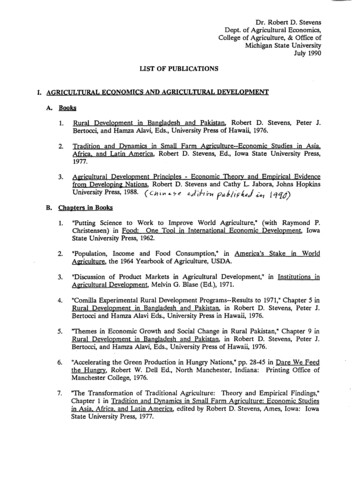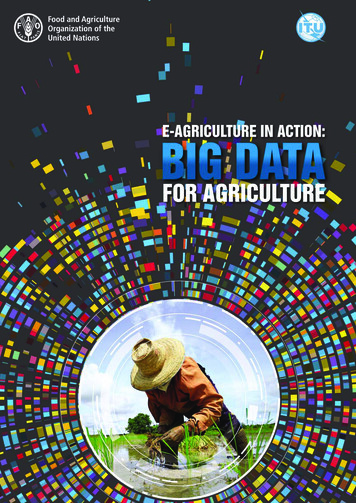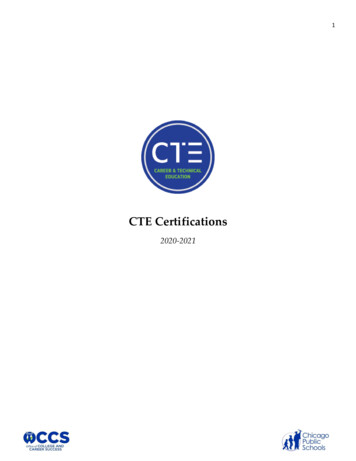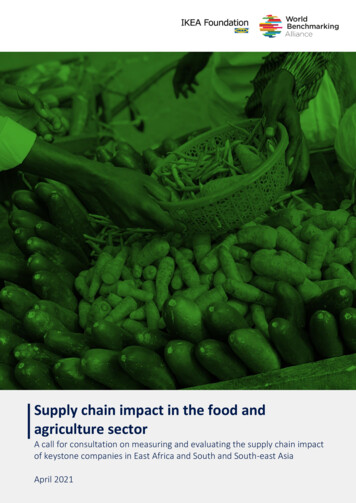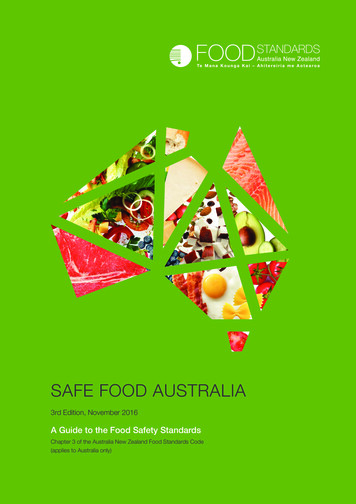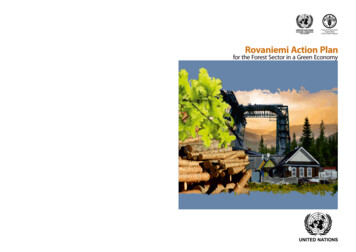
Transcription
Food and AgricultureOrganizationof the United NationsRovaniemi Action Planfor the Forest Sector in a Green EconomyRovaniemi Action Planfor the Forest Sector in a Green EconomyThe Rovaniemi Action Plan for the Forest Sector in a GreenEconomy, adopted on 13 December 2013 in Finland,describes how the forest sector in the UNECE region couldlead the way towards the emerging green economy at theglobal level. It identifies an overall vision, objectives andspecific activities, and identifies potential actors who mightcontribute to achieving the stated objectives. It is not abinding plan, nor does it contain prescriptiverecommendations to Governments, internationalorganizations or stakeholders, who are free to adopt, adapt,in full or in part, or not to implement the Action Plan as theywish. The implementation of the Action Plan will bemonitored by the UNECE/FAO Forestry and Timber Sectionthat will also explore ways and means to measure thecontribution and the progress of the forest sector towardsGreen Economy.UNECE Committee on Forests and the Forest Industry andFAO European Forestry CommissionInformation about forests and forest products and services,as well as information about the UNECE Committee onForests and the Forest Industry and the FAO EuropeanForestry Commission is available on the websitewww.unece.org/forestsMINISTRY OF AGRICULTURE AND FORESTRYGovernment Officesof SwedenInformation ServiceUnited Nations Economic Commission for EuropePalais des NationsCH - 1211 Geneva 10, SwitzerlandTelephone: 41(0)22 917 44 44Fax: 41(0)22 917 05 e.orgUnited Nations publication - Sales No. E.II.E.8 - ISSN 1020-2269Layout and Printing at United Nations, Geneva – 1406075 (E) – July 2014 – 1,499 – ECE/TIM/SP/35ISBN 978-92-1-117078-8UNITED NATIONS
The UNECE/FAO Geneva Timber and Forest Study Paper series contains annual andperiodic analyses of the forest and forest industries sector. These studies are the officialoutputs of regular activities conducted within the Integrated Programme of Work of theUNECE Committee on Forests and the Forest Industry and the FAO European ForestryCommission and are intended to contribute to policy formation. Target audiences aregovernments, industry, research institutions, universities, international organizations,non-governmental organizations, as well as experts from other sectors. Thesepublications often form the basis for discussions of the Committee and the Commissionand their subsidiary bodies.Study papers are usually based on statistics, forecasts and information submittedby country correspondents in the UNECE region (Europe, North America andCommonwealth of Independent States). The basic information is often submitted viaagreed questionnaires, and then complemented by expert analysis from outside andwithin the secretariat. Although study papers are usually issued on the responsibility ofthe secretariat, most often they are the work of many contributors outside UNECE/FAO.When possible, the Study Papers are translated into the three official languages ofUNECE: English, French and Russian. They are United Nations sales publications and aredistributed accordingly through United Nations bookstores and their affiliates. They areautomatically distributed to heads of delegation of the Committee and the Commission,as well as nominated repository libraries, information centres and official distributionlists. They are also available from: publications@un.org and as downloads from www.unece.org/forestsUNECE/FAO Forestry and Timber SectionPalais des NationsCH-1211 Geneva 10, SwitzerlandFax 41 22 917 0041E-mail: info.ECE-FAOforests@unece.org
Forestry and Timber Section, Geneva, SwitzerlandGENEVA TIMBER AND FOREST STUDY PAPER 35Rovaniemi Action Planfor the Forest Sectorin a Green EconomyUNITED NATIONSGeneva, 2014
NoteThe designations employed and the presentation of material in this publication donot imply the expression of any opinion whatsoever on the part of the secretariat of theUnited Nations concerning the legal status of any country, territory, city or area, or ofits authorities, or concerning the delimitation of its frontiers or boundaries. Moreover,the views expressed do not necessarily represent the decision or the stated policy ofthe United Nations, nor does citing of trade names or commercial processes constituteendorsement.AbstractThe Rovaniemi Action Plan for the Forest Sector in a Green Economy, adopted on13 December 2013 in Finland, describes how the forest sector in the UNECE region couldlead the way towards the emerging green economy at the global level. It provides anoverall vision, objectives and specific activities, and identifies potential actors, whomight contribute to achieving the stated objectives. It is not a binding plan, nor doesit contain prescriptive recommendations to Governments, international organizationsor stakeholders, who are free to adopt, adapt, in full or in part, or not to implement theAction Plan as they wish. The implementation of the Action Plan will be monitored bythe UNECE/FAO Forestry and Timber Section which will also explore ways and means tomeasure the contribution and the progress of the forest sector towards a Green Economy.KeywordsBiodiversity, carbon, ecosystem, environmental, erosion, forest policy, forest services,green economy, green jobs, monitoring, payment for ecosystem services, sustainableconsumption and production, valuation of ecosystem services, sustainable forestmanagementECE/TIM/SP/35UNITED NATIONS PUBLICATIONISSN 1020-2269ISBN 978-92-1-117078-8E-ISBN 978-92-1-056766-4
PrefaceA forest sector which contributes to the emerging green economy can be defined asa sector that improves human well-being and social equity while significantly reducingenvironmental risks and ecological scarcities. In every aspect of its activities, it: minimisesits carbon emissions, uses its resources efficiently and is socially inclusive.Why did the UNECE and FAO forestry constituencies decided to seize the opportunityand develop an action plan for the forest sector in a green economy? Because memberStates and stakeholders, including the private sector and the environmental NGOs,believe that the Green Economy is more than a new fashionable concept or a buzz wordfor the post-Rio 20 agenda. This is a real opportunity for the forest sector. Forests arealready delivering renewable, environmentally friendly products and vital services tosociety, and there is great potential for even more.The forest sector might be green and well advanced when it comes to greeneconomy. However, making this statement is not enough, one has to demonstrate howit contributes to a green economy and communicate this to the public, policy makersand to other sectors. One needs to make the case for the forest sector’s role in a greeneconomy. This is one of the primary tasks of the Rovaniemi Action Plan.There is also a need to ensure that the forest sector continues to progress inareas such as decent employment conditions for its workforce, innovating new andsustainable ways of using wood, as well as improving its contribution to biodiversity, soilconservation, climate change mitigation, etc.The Rovaniemi Action Plan is the result of a collective effort. It brought together acommunity of countries, companies, organizations that are now expected to implement,on a voluntary basis, the plan in a joint effort. Get involved and join the partnership forthe Forest Sector in a Green Economy!iii
AcknowledgementsThe first version of Action Plan was drafted early in 2011 by Mr. ChristopherPrins, International Consultant. He also assisted the UNECE/FAO Forestry andTimber Section in further developing the text by integrating the contributions fromstakeholder meetings and the Lviv Forum on Forests in a Green Economy meeting.Inputs from the intergovernmental meetings and written comments fromstakeholders were processed by Arnaud Brizay, Forest Policy Officer at the Forestryand Timber Section and Jakob Hörl, Carlo Schmid Programme Fellow. The finalversion was reviewed by Arnaud Brizay, Paola Deda, Chief and Dominique Reeb,Deputy Chief of the Forestry and Timber Section. Matthew Fonseca of the Forestryand Timber Section finalized the publication with the Publishing Service of theUnited Nations Office at Geneva.The Governments of Switzerland and Ukraine deserve acknowledgement forcoorganizing the Lviv Forum in September 2012. Thanks to the Governments ofTurkey and Finland, for hosting the joint meetings of the UNECE Committee onForests and the Forest Industry and the FAO European Forestry Commission (Turkeyin October 2011 and Finland in December 2013) . All of these events created theneeded dialogue that lead to the adoption of the Action Plan. Many thanks to theGovernment of France, for supporting the Action Plan directly by seconding ArnaudBrizay to the Forestry and Timber Section.Finally, thanks to the many other partners and contributors to the Action Plan,which are listed in annex 2 of this publication. We appreciate the commitment of allin making this document a useful tool to inspire action for the forest sector in a greeneconomy.iv
Table of Contents1.Introduction.11.1 What is the Action Plan?.11.2 Scope and definitions.11.3 Vision.21.4 Overall Goal of the Action Plan.31.5 Principles for the UNECE region forest sector in the emerging greeneconomy.41.6 Follow-up to the Action Plan.5The Action Plan for the Forest Sector in a Green Economy.7Pillar A. Sustainable production and consumption of forest products.9Pillar B. The low carbon forest sector.14Pillar C. Decent green jobs in the forest sector.19Pillar D. Long term provision of Forest Ecosystem Services.23Pillar E. Policy development and monitoring of the forest sectorin relation to a green economy.27Annex 1 Background and Mandate.33Annex 2 List of the Stakeholders Involved in the Developmentof the Action Plan.35UNECE/FAO Publications.412.v
List of Accronyms/AbbreviationsARCMEDArc Forestier MediterranéenCEPFConfederation of European Forest OwnersCFRQCollaborative Forest Resources QuestionnaireCOFFICommittee on Forests and the Forest IndustryEEAEuropean Environment AgencyEFCEuropean Forestry CommissionEFESCEuropean Forest and Environmental Skills CouncilEFIEuropean Forest InstituteEFSOSEuropean Forest Sector Outlook StudyENFEEuropean Network of Forest EntrepreneursEUEuropean UnionEUSTAFOREuropean State Forest AssociationFAOFood and Agriculture Organization of the United NationsFCBAInstitut Technologique Foret Cellulose Bois-constructionAmeublementFCNForest Communicators’ NetworkFLEGTForest Law Enforcement, Governance and TradeFOREST EUROPE the Ministerial Conference for the Protection of Forests in EuropeviFRAGlobal Forest Resources AssessmentFTPForest-based Sector Technology PlatformGFMCGlobal Fire Monitoring CenterIIASAInternational Institute for Applied Systems AnalysisIPPCInternational Plant Protection ConventionISDRInternational Strategy for Disaster ReductionILOInternational Labour OrganizationISOInternational Organization for StandardizationITTOInternational Tropical Timber Organization
IUFROInternational Union of Forestry Research OrganizationsJRCJoint Research Centre, European Commission, IspraLCALife Cycle AssessmentMetlaFinnish Forest Research InstituteNAFSOSNorth American Forest Sector Outlook StudySFMSustainable Forest ManagementSoEFState of Europe’s ForestsTEEBThe Economics of Ecosystems and BiodiversityTTFTimber Trade Federation (UK)UNECE United Nations Economic Commission for EuropeUNEP United Nations Environment ProgrammeUNEP/SETACUnited Nations Environment Programme (UNEP) and the Society forEnvironmental Toxicology and Chemistry (SETAC)UNFCCC United Nations Framework Convention on Climate ChangeUNFF United Nations Forum on ForestsUNISDR United Nations International Strategy for Disaster ReductionVTTTechnical Research Centre of FinlandTIJohann Heinrich von Thünen Institut, GermanyWHOWorld Health Organizationvii
Fotolia 2014viii
Rovaniemi Action Plan for the Forest Sector in a Green Economy11. Introduction1.1 What is the Action Plan?This Action Plan describes how the forest sector in the UNECE region could lead theway towards the emerging green, bio-based economy at the global level. It identifiesan overall vision, strategies and a number of areas of activity. For each area of activity,it proposes objectives and specific actions, and identifies potential actors, who mightcontribute to achieving the stated objectives. It is not a binding plan, nor does itcontain prescriptive recommendations to Governments, international organizations orstakeholders, who are free to adopt, adapt, in full or in part, or not to implement theAction Plan as they wish. How the Action Plan may be implemented is discussed below(Section 1.7).The Action Plan reflects the ideas of participants in the process but does notconstitute a binding commitment by any of them.The Action Plan:1)Describes how the UNECE region’s forest sector could contribute to thedevelopment of a green economy.2)Promotes the sharing and implementation of best practices concerning thegreen economy.3)Promotes the development and implementation of policies for the forestsector which are effective in achieving stated objectives, efficient in the use ofresources and equitable in their treatment of all actors, both inside and outsidethe sector.4)Communicates the potential of the UNECE region’s forest sector to policymakers, the general public and decision makers in other sectors.1.2 Scope and definitionsThe Action Plan addresses the forest sector in all of the UNECE region1 in the contextof the global challenges.1The UNECE region covers 56 countries in Europe, the Caucasus, Central Asia and North America: http://www.unece.org/oes/member countries/member countries.html.
2For the purposes of the Action Plan, the forest sector includes the management of allforests, taking into account the pan-European set of criteria and indicators of sustainableforest management2 as well as:1)The whole range of functions they provide.2)The production, consumption and trade of wood and non-wood forest productsand services.The green economy, according to UNEP, is a system which results in improvedhuman well-being and social equity, while significantly reducing environmental risksand ecological scarcities. In its simplest expression, a green economy can be thought ofas one which is low carbon, resource efficient and socially inclusive.The forest sector in a green economy is, therefore, a forest sector which contributesto the emerging green economy by improving human well-being and social equity whilesignificantly reducing environmental risks and ecological scarcities. In every aspect of itsactivities, it minimises its carbon emissions, uses its resources efficiently and is sociallyinclusive.Preparing the forest sector for the green economy is fully compatible with makingprogress towards sustainable forest management. Indeed a forest sector which playsa leading role in a green economy is promoting sustainable development, both in theforest sector and outside of it.1.3 VisionThe Action Plan is based on the following vision of the forest sector in a greeneconomy:2zzIn a green economy, the forest sector makes a maximum contribution to humanwell-being, through the supply of marketed and unmarketed forest goods and services,and the creation of revenue and livelihoods, while conserving forest biodiversity, andmaintaining and developing forest ecosystem services on a sustainable basis, all withinthe context of a changing climate. A green economy opens up additional opportunitiesfor growth and employment in the forest sector.zzIn a green economy, the forest sector protects the welfare of all stakeholders, including forest dependent indigenous peoples, forest owners, forest industry and the forestryworkforce, uses all resources wisely and economically, and contributes to the mitigationof climate change through both sequestration and substitution, while providing toolsfor climate change adaptation of soef2011.html
Rovaniemi Action Plan for the Forest Sector in a Green Economyzz3In a green economy, forest sector governance systems take into full account all of theecosystem services provided by the forest, compensating suppliers for providing themwhenever appropriate. Progress is monitored in a transparent way, and policies adjusted to reach the goals which will be agreed at the national, regional or local levels. Theforest sector learns from other parts of the emerging green economy and shares its ownexperience with them, to mutual benefit.The vision and the Action Plan as a whole take into account the commitments madeby ECE region Governments in other processes and especially the European Forest 2020decision adopted at the last FOREST EUROPE Ministerial Conference in June 2011 andthe Non-Legally Binding Instrument on All Types of Forests adopted by the GeneralAssembly in December 2007 on the recommendation of the 7th session of the UnitedNations Forum on Forests.1.4 Overall Goal of the Action PlanThe forest sector in the UNECE region makes the greatest possible contribution tothe emerging green economy.
41.5 Principles for the UNECE region forest sector in the emerging greeneconomyThe Action Plan proposes that by 2020, the forest sector be applying the followingprinciples, to achieve its overall goal. In the ECE region, the forest sector:zzUses all its resources, especially those arising from the forest, wisely and economically, minimising waste, recovering, reusing and recycling as much as possible. It consumes only products from forests where it can be demonstratedthat they are managed sustainably.zzContributes to mitigation of climate change by sequestering carbon in forestsand forest products, and by substituting renewable wood-based products andfuels for non-renewable products and fuels.zzCares for and builds up its workforce, developing the necessary skills and significantly improving the occupational safety and health of workers and giving dueconsideration to gender equality.zzMakes sure that the situation of forestry education is reviewed and improved.zzTakes all externalities fully into account in policy making, introducing paymentfor forest ecosystem services whenever appropriate.zzBases its governance on evidence-based decision making and the transparentmonitoring of progress towards sustainable forest management.zzProvides products and services of high user/consumer value.zzSeeks the active participation of civil society and the private sector.
Rovaniemi Action Plan for the Forest Sector in a Green Economy51.6 Follow-up to the Action PlanThe Action Plan proposes a vision, strategies and objectives for the forest sector inthe UNECE region, and possible actions to achieve these. These will be implemented, ona voluntary basis, by international organisations, governments of member States, theprivate sector, civil society and other stakeholders. For each action, possible actors wereidentified by the stakeholder meetings.This Action Plan is meant to inspire action and provide the basis for plans andactivities to focus on the contribution of forests in a green economy. It providessuggestions and is not a work programme for any of the bodies mentioned.The UNECE Committee on Forests and the Forest Industry and the FAO EuropeanForestry Commission invite their member governments to consider how they cancontribute to the implementation of the Action Plan. Some countries could chooseto develop voluntary national action plans or green economy measures for theirforest sector based on the Action Plan. UNECE/FAO could assist those countries indeveloping such plans or measures by facilitating policy dialogues and capacitybuilding activities.It has also been suggested that UNECE/FAO draws the attention of other possibleactors, such as the private sector, to the Action Plan, inviting them, without obligation,to implement actions for which they have been identified as possible actors. In thisregard, public-private partnerships seem to be an effective way to disseminate thegreen economy approach within the forest sector.For their part and taking into account available resources, the Committee andthe Commission will prioritize and incorporate relevant actions identified by theAction Plan that are in their area of competencies into their own annual lists ofactivities, ensuring that the Action Plan and their Integrated Programme of Work arefully consistent with each other. The Action Plan was also developed to be used as atool for communication with other sectors and for awareness raising. It is, therefore,proposed that the Committee and the Commission monitor progress of the forestsector towards a green economy and prepares, as a part of its Integrated Programmeof Work, a report on “the Forest Sector in a Green Economy in the ECE region”using existing information. The secretariat will prepare in due course a proposal onhow to proceed with this evaluation for the consideration of the Committee and theCommission.
Rovaniemi Action Plan for the Forest Sector in a Green Economy72. The Action Plan for the ForestSector in a Green EconomyThe Action Plan consists of 5 pillars with their respective goals:zzSustainable production and consumption of forest productsGoal: Patterns of production, consumption and trade of forest products aretruly sustainablezzA low carbon forest sectorGoal: The forest sector makes the best possible contribution to mitigation(sequestration, storage and substitution) of, and adaptation to, climate changezzDecent green jobs in the forest sectorGoal: The workforce is able to implement sustainable forest management, andthe forest sector contributes to achieving the social goals of the green economyby providing decent jobszzLong term provision of Forest Ecosystem ServicesGoal: Forest functions are identified and valued and payments for ecosystemservices (PES) are established, encouraging sustainable production andconsumption patternszzPolicy development and monitoring of the forest sector in relation to agreen economyGoal: Policies and institutions relevant to the forest sector promote sustainableforest management; policy making is evidence-based, policy instrumentsare effective, efficient and equitable and monitoring is adequate in order tomainstream the green economy in forest sector policies
8Figure 1: Graphic illustration of the Action PlanVision for the ForestSector in a GreeneconomySustainableproduction andconsumption offorest productsA low carbonforest sectorDecent greenjobs in theforest sectorLong termprovision offorestecosystemservicesPolicy Development and monitoring of the forest sectorin relation to a green economyAction Plan for the Forest Sector in a Green Economy
Rovaniemi Action Plan for the Forest Sector in a Green Economy9Pillar A. Sustainable production andconsumption of forest productsGoal: Patterns of production, consumption and trade of forest products are trulysustainablePossible sible actors3Objective: To develop and communicate realistic and ambitious strategies forsustainable patterns of production, consumption and trade of forest products andthe related services4.Governments andDevelop strategies for sustainableprivate sector, consumerproduction and consumption in the greenorganisationseconomy, including, but not only, forestproducts and the related services.UNECE/FAO, stakeholders,Review challenges and opportunities forARCMEDsustainable consumption patterns for forestproducts and the related services (e.g.through a high level conference).Private sector, stakeholders,Promote the use of sustainable forestgovernments, FCN,products (solid, reconstituted, fibre,ARCMEDproducts of biorefineries) in all sectors.All forest related internationalEnsure that the forest sector is appropriatelyorganisations, governments,represented at all international forums onstakeholders, ARCMEDsustainable consumption and production.Science, stakeholders,Evaluate the risks and benefits of including(including consumergenetically modified trees in sustainableassociations, forest owners,forest management and encourage publicEUSTAFOR), governments, FAOdialogue on this question.Objective: To ensure that consumers are fully and accurately informed whetherthe forest products they purchase come from sustainable sources, and thatcertification and labelling systems encourage the sound and sustainable use ofwood and forest products.UNECE/FAO, EU5, certificationMaintain monitoring of developments incertification and labelling, preferably withsystems6, sciencemore analysis of the impact of certificationand labelling in the marketplace.The leading actors are mentioned first.Services may be related, e.g., to forest products (maintenance, planning, servicing, monitoring, programming, patents, R&D,education, consulting, etc.), forests (tourism, recreation, inventory and monitoring, forestry services, etc.), and more generally the“Ecosystem services” (climate services, protection services, etc.) For the ecosystem services, see Part D.During the last round of consultation, EEA informed that it would focus on activities where the EU and/or JRC were identified aspossible actors and would monitor other activities to contribute as appropriate.Both PEFC and FSC confirmed its willingness to contribute to activities where certification systems are identified as potentialactors. FSC was particularly interested in A.1.1, A.1.4 and mentioned that it was already involved in activities such as thoseproposed for A.1.5.
10A.1.2Consider policy frameworks forharmonised labelling and certificationsystems for forest products.UNECE/FAO, stakeholders,including certificationsystems, EU, governments,stakeholders/private sectorA.1.3Further develop standards and guidelinesat a national and local level which maysatisfy the requirements of more thanone certification system, thus simplifyingprocedures and reducing costs.Governments, certificationsystems, forest owners, allstakeholdersA.1.4Review experience with certification offorest owners/managers and stakeholdersthroughout the value chain: has it changedsilvicultural practice? Are the costsbearable? Has it opened new marketsor developed old markets? Has forestcertification given a competitive edge to itsusers throughout the value chain?Science, certificationsystems, forest owners,stakeholders,A.1.5Further develop, in a holistic manner,standards that consider forestry in thecontext of other land uses, making forestcertification relevant to non-traditionalforest users, and adaptable to the needsof those that are not yet certified and forwhom forest certification may currently bea barrier, in order to further encourage thesound and sustainable use of wood andforest products.Certification systems, forestowners, EUSTAFOR, allstakeholdersA.2Objective: To help public and private buyers of forest products to develop andimplement procurement rules which encourage sustainable practices andpromote demand for certified forest products.A.2.1Link the development of procurementpolicies to existing legislation andpractice on sustainable consumption andproduction.EU and other procurementauthorities, certificationsystemsA.2.2Work to promote procurement policies,public and private, that adequately takeinto account sustainability considerations,for instance the use of certified forestproducts, and do not discriminate againstforest products.Procurement authorities, EU,governments, private sectorand consumer organisations,ARCMED
Rovaniemi Action Plan for the Forest Sector in a Green EconomyA.3Objective: To ensure that wood supply from the region’s forests is sufficient tosatisfy, on a sustainable basis, society’s needs for renewable raw materials andsources of energy.A.3.1Generate information and data to supporteffective forest planning, includingthrough national forest inventories.UNECE/FAO, FORESTEUROPE, ITTO (CFRQinitiative), JRC, governmentsA.3.2Take into consideration the Good practiceguidance on sustainable mobilisation ofwood in Europe (2009) or equivalent NorthAmerican guidelines and initiatives whendeveloping wood mobilisation policies andinstruments.Governments, private sector,forest owners, stakeholdersA.3.3Carry out national studies on opportunitiesto increase the potential sustainable woodsupply.Governments and relevantstakeholders, JRCA.3.4Carry out research into the social andeconomic drivers of wood supply, forinstance motives and values of nontraditional forest owners, supply curves forwood removals.IIASA, EFI, Metla;governments, private sectorsand forest owners, JRC, TI,ARCMEDA.3.5Invest in the forest sector, including forestinfrastructure, for wood mobilisation.Governments, private sector,forest
Commonwealth of Independent States). The basic information is often submitted via agreed questionnaires, and then complemented by expert analysis from outside and within the secretariat. Although study papers are usually issued on the responsibility of the secretariat, most often they are the work of many contributors outside UNECE/FAO.




